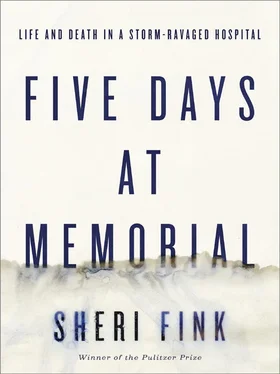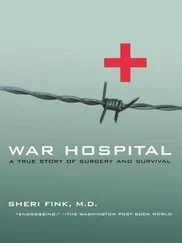Hospital emergency plans were supposed to be based on a yearly analysis of vulnerability to a variety of potential emergencies or “hazards.” Every year since 2001, Mulderick had convened Memorial’s emergency preparedness committee to go over a three-page form covering some forty-seven events, from volcanic eruptions to nonfunctioning fire alarms and an undefined “VIP situation.” Unlike some other hospitals, Memorial had never hired a consultant for this task. Instead, Mulderick and her committee evaluated their own preparedness at a time they were under pressure from above to save money. The template the committee used could be downloaded for free from the Internet, and other New Orleans hospitals also used it. Mulderick and her committee produced a matrix of scores estimating probability, risk, and preparedness for each event. The latest rendering was rife with multiplication errors.
Mulderick’s committee had rated the hospital’s preparedness for power outages, generator failure, and floods as “good”—the top ranking on the scale. In designing their plans, committee members would later say they thought more about the constellation of emergencies that had happened rather than the worst things that could happen.
Whether scoring the “probability,” “risk,” and “preparedness” for volcano eruptions in Louisiana was a true contribution to disaster preparedness could certainly be questioned.
Years after Katrina, Bob Wise would look critically at Memorial’s twenty separate emergency preparedness plans. “They have nothing to do with each other,” he would say. “Nobody can know this many plans.” Memorial, he felt, had missed the point of JCAHO’s new preparedness standards, putting down on paper what was needed to pass accreditation inspection rather than focusing on cross-cutting “all hazards” preparedness. “It’s not the guts of what you’re supposed to be doing. It’s covering your ass, is what it’s doing.” He found this all too often.
Memorial was now facing its first real crisis. Despite years of emergency preparedness committee meetings and revisions of the hospital’s disaster plans, in many ways the hospital would have to wing it.
TO ICU NURSE manager Karen Wynn, the moment Susan Mulderick announced in their hastily organized meeting that floodwaters were headed their way, the atmosphere in the command room shifted from a hospital emergency to a military operation. There was one objective: act quickly before the power failed.
Nearly two hundred Memorial patients needed to be brought to safety. Mulderick suggested that the sickest, the ones most dependent on life support or mechanical aids, should go out first. That meant around two dozen patients in the ICUs, a similar number in the newborn nursery, high-risk pregnant mothers, and around a half dozen dialysis patients, with more showing up since the storm. There were also two bone marrow transplant patients highly vulnerable to developing infections. It would be difficult to care for them if all power was lost. Others at the command meeting agreed.
The tougher question was how to move them. Susan Mulderick knew the looming catastrophe was bigger than the staff at Memorial could handle alone. A National Guard unit had spent the hurricane at Memorial, and a few Acadian ambulances were parked on the ER ramp. Mulderick asked if Acadian could provide more ambulances and even helicopters. She sent an e-mail to her ex-husband, a buyer at a helicopter-transport company, asking if his firm could help get a helicopter to fly in medications and fly out patients. He wrote back to tell her that the company had already been hired to evacuate people from another private hospital, Tulane. He sent her the phone number of an Air National Guard major with a Baton Rouge exchange who was, he wrote, coordinating all civil and military evacuation efforts.
Karen Wynn wondered about the feasibility of an evacuation by helicopter. Memorial’s heliport hadn’t been used in years. The last time she could remember going up there was for an emergency drill in 1987, when Pope John Paul II visited New Orleans. She left that for others to contemplate and returned to the ICU to let the staff know that evacuation was imminent and they would need to get the patients’ medical records and medications ready.
A CALL WENT out over the public address system. “Prayer service… ten thirty a.m.” Everyone at the hospital was invited to attend.
Father John Marse was the only chaplain present at Memorial during the storm. He had decided to stay after hearing the voice of God calling him to serve. Now the Catholic father carried his sacramentary and lectionary out of the dim Myron C. Madden Chapel, windowless but for the narrow, stained-glass strips that decorated its two wooden doors. He stood with several dozen people in the well-lit hospital entrance lobby. Father Marse, who spoke quickly in a Southern drawl, began reading from Matthew:
And, behold, there arose a great tempest in the sea, insomuch that the ship was covered with the waves: but he was asleep. And his disciples came to him, and woke him, saying, Lord, save us: we perish. And he saith unto them, Why are ye fearful, O ye of little faith? Then he arose, and rebuked the winds and the sea; and there was a great calm.
We’re in this storm, Marse said in a brief homily for those gathered before him. And Jesus is with us, no matter what the outcome is.
Marse couldn’t help noticing that the water outside the windows of the entrance rose halfway up the side of a fire hydrant during the time he spoke.
Sandra Cordray, a community relations manager who was the designated communications leader for Katrina, asked Marse to attend all future command meetings. Memorial needed help from every possible power.
Memorial had another power at its disposal by virtue of having been swallowed by a hospital chain. Cordray took charge of communicating with executives at Memorial’s parent company, Tenet Healthcare. With phone connections difficult to make, but e-mail still functioning, she wrote for help, explaining that water was rising in Memorial’s basement and was expected to keep rising for days. The hospital was locked down because of reports of looting in the area, and other hospitals were evacuating. She said that the National Guard was present at the hospital, and she forwarded the phone number of the Air National Guard major identified by Mulderick’s ex-husband in the hopes that someone at headquarters could contact him. She also shared what she was hearing about the increasingly frightening situation in New Orleans.
From: Cordray, Sandra
Sent: Tuesday, August 30, 2005 11:00 AM
Subject: reports
We are receiving reports that the inmates at the prison near Tulane have taken over.
From: Cordray, Sandra
Sent: Tuesday, August 30, 2005 11:07 AM
Subject: RE: reports
Break in the 17th street canal levee—200 feet wide flooding New Orleans
Cordray’s e-mails to Tenet’s Dallas headquarters grew more panicked by the minute. Sean Fowler, Memorial’s chief operating officer, pulled his chair up to hers and instructed her as she typed. Memorial needed to evacuate its patients. Memorial needed medicines and blood products. What did Tenet have in terms of supplies, medicines, water, and food? How quickly could the company deliver them? What kind of airlift and ground resources was the corporate office coordinating?
WE NEED PATIENTS OUT OF HERE NOW!
Please can you take patients.
Is anyone out there?
Michael Arvin, an executive at Tenet headquarters, finally responded. “We have been told getting into the city is not going to happen,” he wrote. “Have you contacted the National Guard?” It was an odd question. Cordray had already informed Arvin that Guard members were at the hospital. That contingent alone could not solve all these problems.
Читать дальше













